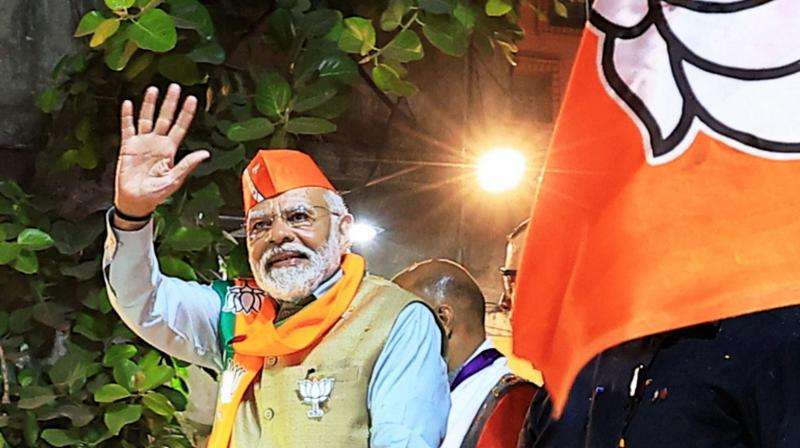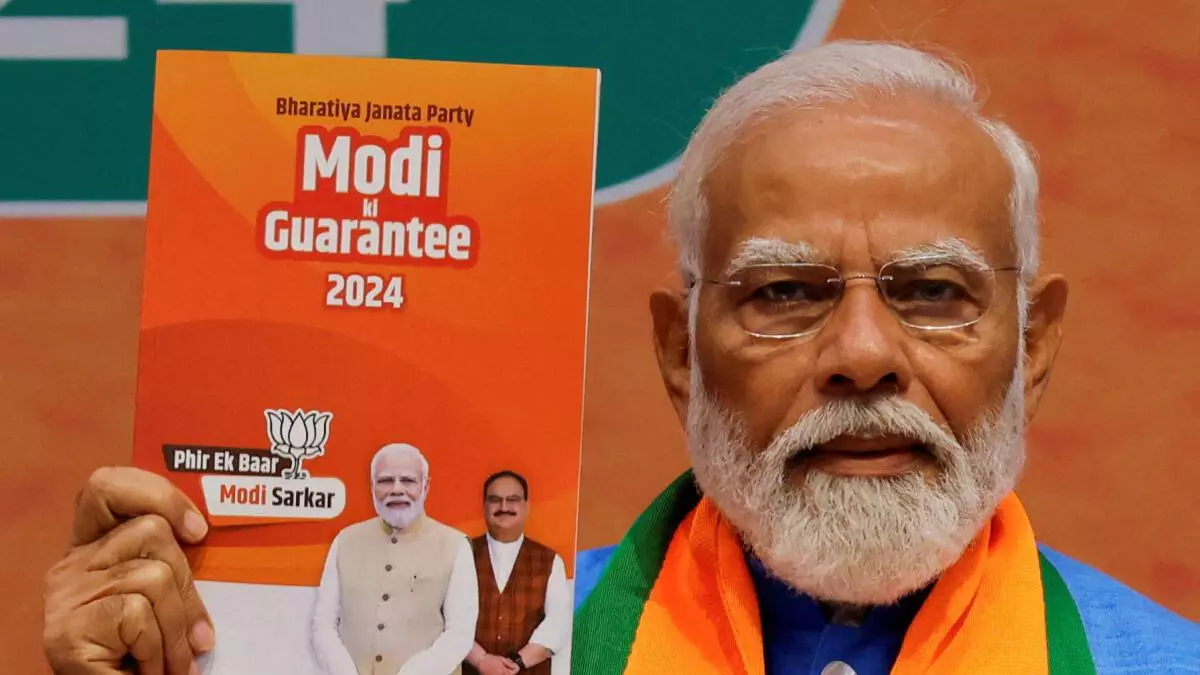Has Modi Done His Magic Yet Again, Exit Polls Suggest So; The Vital Question, Can Markets Tumble Even If Modi Wins? Why Are Most Indian Business Owners Afraid To Criticise Modi Government Publicly?

It seems that the BJP’s tagline ‘Abki baar 350 khatakhat paar’ may indeed come true. Still, only poll results on June 4 will decide if Modi returns to power because exit polls are not always very accurate. If he does, he will be the second prime minister after Nehru to win a third term.
Exit polls on Saturday evening forecast a sweeping victory for the ruling BJP-led National Democratic Alliance (NDA) in the general election, surpassing its 2019 numbers.
Some exit polls even suggested the NDA could reach 400, Prime Minister Narendra Modi’s key campaign goal.
The Lok Sabha has a total of 545 members, two of whom are nominated. The general election was conducted in seven phases between April 19 and June 1, and the exit polls were released after voting concluded on Saturday.
 The Predictions
The Predictions
India Today-Axis My India and News24-Today’s Chanakya projected that the NDA would secure around 400 seats. The former estimated the NDA would win between 361 and 401 seats, with the opposition INDIA bloc at 145.
The ABP-CVoter survey indicated the NDA might achieve 368 seats and the INDIA bloc 167.
According to TV9 Bharatvarsh, the NDA is expected to get 342 seats while the INDIA grouping could secure 166 seats.
The Times Now-ETG survey predicted the NDA would win 358 seats and the opposition bloc 132 seats.
At the same time, almost all exit polls predicted significant gains for the BJP in the south as well as in West Bengal and Odisha.
Hence, as the mass exit polls suggest a great ‘green’ for the BJP, what may have worked in the party’s favour?
The only probable answer is that the BJP appears to have convinced its voters that it is working in their best interest. Despite the opposition’s enticing promises, BJP supporters continue to rally behind the Modi government.
Moreover, it also suggests that the release of the electoral bonds data, caste survey, wealth redistribution, and the Agniveer factor—Congress’s promises—have had little impact on the voters.
Small Yet Big Wins
A return of the BJP with results as predicted by exit polls would signify a strong vote of confidence in the Modi government.
However, as some conservative exit poll estimates suggest, the NDA’s failure to surpass the 400-seat mark indicates that the BJP has not significantly expanded its voter base.
A third consecutive term for Modi with a similar number of seats and vote share would suggest that his supporters remain steadfast in their belief in his leadership.
On the other hand, if the NDA reaches the 400-seat mark, as a few exit polls predict, it would indicate that a significant number of voters who supported opposition parties in 2019 have switched to Modi this time.
Now that we have looked into what the exit polls suggest, the most critical question, as it is directly related to the outlook of the Indian economy—the stock markets and the FIIs.
 Can Markets Take A Dip?
Can Markets Take A Dip?
In the coming days, as India tallies political winners and losers as the final phase of voting for the General Election concludes, the stock market will deliver its own verdict when markets open on ‘D-day’.
Although ballot counting begins on June 4, exit polls from local media outlets are expected to emerge soon after voting ends on Saturday. Therefore, the market reaction on Monday will be critical.
Investors are worried that without a substantial victory for Prime Minister Narendra Modi’s BJP, the government might be hindered in implementing major economic reforms.
While the BJP-led coalition held nearly 350 seats — more than 60% — in the previous Parliament, India headed to the polls with markets anticipating the incumbents to achieve a record 400 seats.
A substantial majority would enable Modi to implement constitutional amendments and reform land acquisition and labor laws, which analysts believe are essential for accelerating India’s economic growth.
Traders drove the benchmark NIFTY 50 index to an all-time high last week, closing above 22,967 points, in anticipation of favorable election results.
- “With the index reaching new all-time highs, the market is increasingly dismissing the risk of an unexpected loss for the BJP-led coalition,” noted Bank of America analysts in a recent research report.
They suggest that the equity options market anticipates stocks to fluctuate — either up or down — by 4.5% on the first trading day following the election results.
This implies that initial concerns over low voter turnout and tight contests, which had driven up the India VIX, have now been set aside.
- “While the BJP’s talk of securing 400 seats before the election was likely more political bravado than a realistic goal, it did enter the election with the largest single-party majority in nearly 40 years,” said Bradley Saunders, assistant economist at Capital Economics.
“Moreover, the BJP performed well in state elections at the end of last year. Considering this, the BJP would have had to lose a significant amount of support in a short period not to secure another parliamentary majority,” Saunders added.
In a note to clients, Saunders also referenced data from the Election Commission, which shows that while voter turnout is lower than in the 2014 and 2019 elections, it remains in line with the historical average.
However, some equity strategists caution that even a landslide victory for Modi’s BJP could negatively impact the stock market, following the classic “buy the rumor, sell the news” scenario.
- “We anticipate a short-term breach of the 23K Nifty target, but a swift profit booking will likely bring it back below that level,” said Bernstein’s strategist Venugopal Garre.
“Market expectations of continued power were already factored in, which explains the rally in November and December last year. Repeatedly betting on the same outcome can lead to unrealistic valuations — hence, we believe the focus will eventually return to macroeconomic fundamentals, earnings growth, and reasonable valuations,” Garre added.
 The Resounding Fear
The Resounding Fear
However, among all the positives, a paradox is secretly playing out—the Indian business scene today is that while the Bharatiya Janata Party’s electoral victories have been celebrated resoundingly on the stock market, many businessmen remain fearful of the party’s government in New Delhi.
Four years ago, Rahul Bajaj (now deceased) told Amit Shah that industrialists were afraid to criticize the government because they feared such criticism ‘would not be appreciated’.
He also mentioned that none of his industrialist friends would dare to admit this fear publicly.
Bajaj compared the current atmosphere with the days of the Manmohan Singh government when criticism was freely expressed. In response, Shah asserted that his government had faced more criticism than any other, both in Parliament and outside, and there was no need to fear the government’s response.
Shah further emphasized that it was not the government’s intention to instill fear in anyone.
However, informal surveys indicate that businessmen continue to be wary of the government and its ‘agencies’.
Business lobby groups report that they have been advised not to criticise the government publicly; meanwhile, the stock market, reflecting both foreign institutional and domestic investor enthusiasm, shows no such fear, only hope.
 What Indian Businessmen Really Want
What Indian Businessmen Really Want
What businessmen often express is a desire for the Narendra Modi government to return after next summer’s election, but as a minority, requiring coalition partners who might curb any high-handed actions.
- There are stories of companies being targeted by favoured businessmen, with their owners suddenly attracting the attention of the tax authorities, but after the target company changes hands, the tax issues often disappear!
- Moreover, there is talk that businessmen intending to bid at auctions as part of the bankruptcy process are reportedly advised to stay away while someone more favoured wins the auction.
However, despite these concerns, businessmen prefer the Modi government due to several business-friendly measures, such as lowering the corporate tax rate and extending tariff and non-tariff protections to domestic producers against imported competition (most Indian businessmen, including Rahul Bajaj, have historically been sceptical of globalization).
Also, indirect taxation has been reformed, subsidies are being offered for investment, and incentives for increased production.
There is also unprecedented public investment in physical infrastructure; therefore, the advantages add up more, so why criticize?
Businessmen perceive the Modi government as offering stability and continuity.
No one wants a repeat of the chaos of past coalition governments (the likely alternative in the very remote possibility of a non-BJP government post-elections) or the policy paralysis of the later years of the Manmohan Singh government.
Whether there is less ‘tax terrorism’ now than under Congress rule is possibly an open question, but there is another factor to consider.
The current Congress message focuses primarily on welfarism and freebies, which are interpreted as fiscal irresponsibility and the party offers no accompanying pro-business message.
Hence, in this scenario, the Modi-led government wins hands down!
So what do the exit polls predict in terms of the number of seats state-wise?
 The Seat Breakup –
The Seat Breakup –
Karnataka and Southern States
The BJP is expected to win 20-25 seats in Karnataka, a slight decrease from its 2019 tally of 26.
Additionally, the BJP is likely to make inroads in Tamil Nadu, Kerala, and Andhra Pradesh.
In Tamil Nadu, the BJP-led NDA could secure two to four seats out of 39, with Today’s Chanakya predicting 10 seats.
In Kerala, the party might win two to three seats out of 20.
In Andhra Pradesh, where the BJP contested in alliance with the Telugu Desam Party (TDP) and the Jana Sena, the NDA is projected to win 21 to 25 seats out of 25, marking a significant turnaround according to major exit polls.
Maharashtra
In Maharashtra, where the NDA faced off against the Maha Vikas Aghadi (MVA), the NDA appears to have lost some ground but still leads according to exit polls.
The polls estimate the NDA’s seat tally to be between 24 and 34 out of a total of 48 seats.
Uttar Pradesh
In Uttar Pradesh, a key state with 80 seats, the BJP seems poised to exceed its 2019 tally of 62 seats plus two won by allies.
Most exit polls predict the NDA will secure close to 70 seats, leaving eight to 10 seats for the Congress and Samajwadi Party alliance.
Odisha and West Bengal
The BJP is projected to achieve significant victories in Odisha and West Bengal.
In Odisha (21 seats), the BJP could win 18-19 seats, up from eight in 2019.
In West Bengal (42 seats), the BJP’s tally could reach 28, compared to 18 in 2019.
Losses and Gains
The NDA is expected to experience some losses in Haryana, Bihar, and Rajasthan, with a reduction of 10-12 seats across these three states.
However, substantial gains in other states are likely to offset these losses, potentially taking the NDA well beyond its 2019 figure of 353 seats, according to the exit polls.
The Last Bit; as the results of the elections will be soon out putting speculations to end, one thing is certain-India needs to move forward.
The Indian economy needs to maintain its stride to achieve its goal of becoming the third largest economy in the world, at the same time there are significant challenges to tackle-the rising unemployment, the growing inequality in wealth distribution and the growing sentiment of internal divide.




